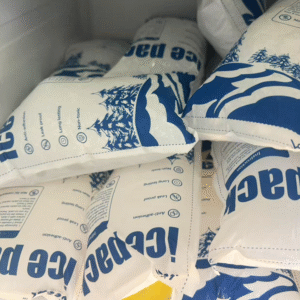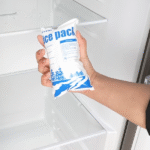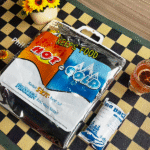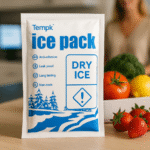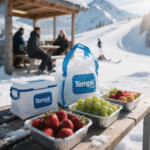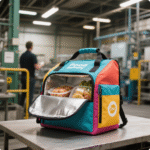In 2025, dry ice packs wholesale helps you keep frozen products at −78.5°C with fewer claims and cleaner audits. Start with 5–10 lb per 24 hours, validate on your hottest lanes, and follow IATA PI 954’s 200 kg per package ceiling. This guide shows you exactly how to size, pack, label, and ship—so you cut spoilage while staying compliant. You’ll also see when to switch to gel packs or PCM.
-
How to size dry ice packs wholesale for 24–72 hours using a simple rule of thumb and calculator (your dry ice packs wholesale estimator is below).
-
What UN1845 labels, airway bill fields, and venting rules you must follow in 2025 when shipping dry ice packs wholesale.
-
Which insulation beats heat for dry ice packs wholesale: EPS vs PUR vs VIP, and how wall thickness changes hold time.
-
When to use gel packs or PCM instead of dry ice packs wholesale for chilled lanes—and how to combine them.
How should you size dry ice packs wholesale for 24–72 hours?
Start with 5–10 lb per 24 hours per medium insulated shipper, then adjust for insulation, ambient heat, and porch dwell. Convert pounds to kilograms for air labels and log each pilot run. Begin with frozen product, keep void space tight, and plan a 10–20% buffer in summer for dry ice packs wholesale lanes. Most teams reach stable results after two or three lane tests with data loggers and delivery-weight checks.
Why it works: Sublimation rises with poor insulation and airflow. If your EPS wall is under 1.5–2 inches or you expect >30 °C routes, you’ll need more refrigerant. Upgrade insulation first; adding mass is your second lever. For aircraft safety, regulators model CO₂ buildup conservatively—don’t confuse those assumptions with hold-time planning. Pilot on your hottest lane, then standardize a table per box size for dry ice packs wholesale programs.
How much dry ice per day do you really need?
A practical midpoint is 7.5 lb/day for a medium EPS shipper. Add +2 lb/day for thin EPS (<1.5″) or hot lanes, and subtract 1 lb/day when using VIP inserts. Always include an extra day if doorstep dwell is common. Validate with three boxes and tune ±15–20% from the midpoint.
| Sizing scenario | Insulation | Transit | Suggested dry ice | What it means to you |
|---|---|---|---|---|
| Frozen meals | EPS 1.5–2″ | 48 h | 16–20 lb | Baseline for typical D2C orders |
| Ice cream, summer | EPS 2″ | 48–60 h | 22–28 lb | More buffer for porch time |
| Biologics | VIP shipper | 24 h | 6–8 lb | Premium insulation reduces mass |
Practical tips that actually save shipments
-
Stage close to packout: Reduce open-air time so sublimation starts in the box, not on the dock.
-
Place refrigerant above the payload: Cold falls; spacing prevents “freezer burn” spots.
-
Instrument pilots: Use data loggers and weigh remaining dry ice at delivery; adjust by +/–15%.
Real-world case: A national ice‑cream brand standardized vented lids and 2″ EPS, then tuned mass by lane. Summer “soft product” complaints fell 23% while deliveries held at ≤ −18 °C during 48‑hour ground routes.
Use this quick calculator to plan dry ice packs wholesale loads per order.
What packaging and insulation pair best with dry ice packs wholesale?
Pair dry ice packs wholesale with rigid insulation (≥1.5–2″ EPS or better), a ventilated lid or loose-fit liner, sturdy outer corrugate, and snug dunnage to minimize headspace. Thicker walls and tighter void fill cut sublimation; vent paths prevent pressure buildup in dry ice packs wholesale shipments. PUR improves R‑value over EPS; VIPs perform best but demand careful handling and cost more.
EPS vs VIP—what cooler thickness is enough?
Use EPS 1.5–2″ as the minimum for frozen foods. Consider VIP panels on hot lanes, 48–72‑hour routes, or high‑value payloads to cut refrigerant mass by ~10–20%. Avoid hermetically sealed inner liners with dry ice; CO₂ must escape.
| Insulation choice | Typical wall | Relative performance | What it means to you |
|---|---|---|---|
| EPS (polystyrene) | 1.5–2.0″ | Good | Low cost; add more dry ice on hot lanes |
| PUR (polyurethane) | 1.5″ | Better | Smaller boxes at same hold time |
| VIP panels | 0.5–1.0″ | Best | Highest hold; reduces mass and DIM weight |
Packout details that matter
-
Reduce headspace: Right‑size shippers; add paper or foam dunnage.
-
Double‑box for abuse: Dry ice is brittle; protect packs from impact.
-
Standardize inserts: Keep dry ice separated from food surfaces in dry ice packs wholesale packouts.
How do you label and ship dry ice packs wholesale in 2025?
For dry ice packs wholesale, mark every carton with “Dry Ice” (or “Carbon Dioxide, Solid”), “UN1845,” the net weight of dry ice in kilograms, and shipper/recipient names and addresses; apply a Class 9 label and ensure venting. When cooling non‑dangerous goods, no Shipper’s Declaration is required under IATA PI 954; your airway bill must still note dry ice. Some services cap packages at 200 kg of dry ice—confirm with your operator.
UN1845 labeling made simple for dry ice packs wholesale
-
Weigh remaining dry ice at packout; convert lb → kg (2.2 lb = 1 kg).
-
Print above the label area (don’t write on the label itself):
-
“Dry Ice” or “Carbon Dioxide, Solid”
-
“UN1845”
-
“Net ___ kg of dry ice”
-
Shipper & recipient names/addresses
-
-
Apply Class 9 label; keep the face clean.
-
Ensure ventilation (no hermetic inner seals); use a vented lid or liner.
When should you choose gel packs or PCM instead of dry ice packs wholesale?
Use dry ice packs wholesale when you must hold products at ≤ −18 °C for 24–96 hours. Use gel packs or PCMs for chilled targets (0–8 °C) or to avoid over‑freezing sensitive SKUs. If you don’t need deep‑freeze, skip dry ice packs wholesale to save cost and complexity. Many brands run a hybrid—dry ice for frozen SKUs and PCMs for chilled items in the same parcel—to control zones and lower damage.
Dry ice vs gel packs vs PCM—what’s the right fit?
| Option | Target temp band | Typical mass per 24 h | What it means to you |
|---|---|---|---|
| Dry ice packs wholesale | ≤ −18 °C | 5–10 lb | Best for frozen foods and long routes; requires UN1845 labels |
| Gel packs | 0–10 °C | Heavy | Simple compliance; great for short, chilled lanes |
| PCM (e.g., −21 °C or +5 °C) | Set‑point specific | Moderate | Precise holds; reusable; reduce over‑cooling risk |
Actionable selection tips
-
If your failure mode is summer thaw, upgrade insulation first; then reduce dry ice mass.
-
For mixed‑temp parcels, separate zones: PCMs around produce; dry ice above frozen items.
-
For biologics, pre‑freeze to target temp, use VIP shippers, and document ISTA 7D/7E validation.
Quick self‑check: Is dry ice packs wholesale your best fit?
-
Target temp ≤ −18 °C? Choose dry ice packs wholesale; otherwise consider PCMs for 0–8 °C.
-
Transit > 24 h or porch dwell likely? Dry ice packs wholesale beats gel on hold‑time per pound.
-
Air shipping required? Confirm UN1845 marking and PI 954 venting before tendering.
2025 trends shaping dry ice packs wholesale and the cold chain
The frozen e‑commerce surge, stricter acceptance checklists, and reusable packaging growth are reshaping dry ice packs wholesale strategies. Same‑day grocery expands porch dwell time, VIP and high‑R paper shippers cut refrigerant needs, and CO₂ capture investments are easing some regional supply constraints. Expect dry ice demand to rise alongside frozen food and biologics through the early 2030s; plan contracts and safety training accordingly.
Latest progress at a glance
-
Faster perishables delivery: More same‑day/next‑day lanes mean you must plan extra hold for doorstep time.
-
Rise of reusables: Validated VIP/paper shippers reduce mass and dimensional weight on hot lanes.
-
Clearer acceptance: 2025 PI 954 job aids highlight venting, net‑kg markings, and no‑declaration rules for non‑DG cargos.
Market insight: Dry ice and reusable cold‑chain packaging both track mid‑single‑digit to high‑single‑digit annual growth into the 2030s. That means tighter Q3/Q4 supply and price swings in some regions. Forecast volumes early and dual‑source near production hubs to hedge seasonality.
Frequently Asked Questions
How much dry ice per day should I plan?
Start at 5–10 lb per 24 h per medium EPS shipper, then adjust for insulation and heat in your dry ice packs wholesale program. Validate with three‑box pilots and log remaining weight at delivery.
What must be printed on the box?
“Dry Ice” or “Carbon Dioxide, Solid,” UN1845, the net kg of dry ice, and shipper/recipient names/addresses—plus a Class 9 label for dry ice packs wholesale. Keep labels visible and packages vented.
Do I need a Shipper’s Declaration for air?
Not when dry ice packs wholesale is used only to cool non‑dangerous goods. Still note dry ice and net kg on the airway bill and follow PI 954.
Can dry ice touch food?
Avoid direct contact. Use separators or trays to protect surfaces and prevent “freezer burn.”
What exposure limits apply to CO₂ in packout areas?
Follow OSHA/NIOSH guidance: 5,000 ppm TWA and 30,000 ppm STEL. Ventilate, monitor, and train staff; provide insulated gloves and eye protection.
Summary & recommendations
Use dry ice packs wholesale for ≤ −18 °C holds of 24–72+ hours, start at 5–10 lb/day, upgrade insulation before adding mass, and follow UN1845 + PI 954 venting/marking. Commit these dry ice packs wholesale basics to your SOPs to keep audits clean. Right‑sized packaging, disciplined labels, and lane‑level pilots lower cost and claims. Dual‑source supply near CO₂ production and add a 10–20% summer buffer.
Next steps (action plan)
-
Run a 3‑box pilot on your hottest lane with data loggers.
-
Standardize packouts (≥1.5–2″ EPS or VIP hybrid) and label templates.
-
Automate net‑kg math at packout; add 10–20% summer buffer.
-
Pre‑book dry ice packs wholesale supply with two regional partners and review training quarterly.
About Tempk
We design practical cold‑chain solutions that hit the right temperature with the least refrigerant. Our engineers qualify lanes under ISTA 7D/7E, compare EPS vs VIP hold times, and deliver SOPs you can deploy quickly for dry ice packs wholesale operations. Two advantages you’ll notice fast: lower spoilage and cleaner operations across hubs.
Talk to an expert: Book a 30‑minute review and get a lane sizing worksheet tailored to your routes.






